
International Research Journal of Engineering and Technology (IRJET) e-ISSN: 2395-0056
Volume: 12 Issue: 01 | Jan. 2025 www.irjet.net p-ISSN: 2395-0072


International Research Journal of Engineering and Technology (IRJET) e-ISSN: 2395-0056
Volume: 12 Issue: 01 | Jan. 2025 www.irjet.net p-ISSN: 2395-0072
Dr. Dada S. Patil
Associate Professor, Department of Civil Engineering, AIKTC, SoET, Panvel, Navi Mumbai, India
Abstract - As per Bloom’s revised taxonomy, six levels of learning in ascending order are depicted by the verbs: Remembering, Understanding, Applying, Analyzing, Evaluating and Creating. Outcome Based Education (OBE) focuses on design of curriculum and effective teaching, with reference to the outcome that learners would exhibit after being taught. OBE’s instruction planning mechanism is a reverse of that associated with the Traditional Education Planning (TEP). As a requirement of OBE framework, engineering teachers generally adopt five to six course outcomes (COs) for a particular course; usually a CO belongs to a module. The combination of module-level COs leads to a Course Outcome of a particular course. Learning level is decidedbasedona verb or combinationofverbsusedintheCO statement. However, the attainments of desiredlearning level and CO in a true sense depends upon various factors such as depth of teacher’s knowledge, his/her reference materials, his/her ability to teachconceptuallyratherthanmechanically, learners’graspingcapacity,theirlogicalskills,etc.TheCOand learning level are shown to be attained as a part of documentation; however, their practical realization remains an ambiguous issue. In this paper, learning level 4 problem, analysis of a statically determinate, perfect, stable pin-jointed plane truss by method of joints has been attempted; once by mechanical approach and once by logical and conceptual approach inorder to demonstrate the advantage of later over the former for attaining the CO andlearning level intheirtrue essence and not as a mere formality.
Key Words: Bloom’s learning levels, teaching-learning, course outcome, structural analysis, OBE, etc.
Engineeringinstitutesarestrivinghardtoequipthecurrent generationlearnerswiththeskillsrequiredtofacethereal world challenges. This is because of traditional curricula being taught to the engineering graduates. Such curricula focus on teacher-centric learning method [1]. A large gap getscreatedbetweentheskillsimpartedtotheengineering graduatesandtheskillsneededtosucceedintheircareer. However, OBE philosophy can reduce this gap to a large extent [2]. OBE stresses upon learner-centric teachinglearning mechanism. It defines clear-cut outcomes which learnersshallattainafterundergoingaparticularcourseand program of study. OBE gives more impetus on the
competencies,skill-sets,knowledgeanddesiredoutcomes that learners should gain. For more organized and transparent educational mechanism, teaching strategies, questionpapersettingandassessmentshouldbeperfectly alignedwiththedesiredoutcomes.
Itisusuallypresumedthattheengineeringlearnersareselfmotivated;theycanusetheirwell-developedcognitiveskills tograsptheconcepts.However,engineeringteacherplaysa vital role in inculcating them in such a way that they can grasp the concepts most efficiently [3]. The instructional strategiesofateachergreatlyinfluencetheeffectivelearning andacademicexcellenceofthelearners[4].Goodteachingis a combination of various parameters such as in-depth knowledge, pedagogical skills, ability to teach the same concept in a numberofways,motivatingthe learners and strongcommitmenttowardsthelearners[3].
Asystematicstrategyforadoptingastreamlinedcurriculum forengineeringprogramsinlinewithOBEisdemonstrated [5]toenhancethequalityofgraduatingstudents. Viewsof teachers and learners on the engineering curriculum and industryrequirementsarediscussed[6]inordertodecide upontheactionstobetakentoimprovegraduatingstudents’ skills. A model was presented [7] to enhance curriculum compliance in connection with the graduating attributes’ attainments.
Inthisarticle,intentionally,averysimpleandbasicproblem of truss analysis has been chosen for the demonstration purposesothattheauthor’sviewsandopinionscanreachto thewidespectrumofreadersinalucidway.
Cognitivelearningconsists oflearningskills inconformity with the thinking mechanism. Bloom’s taxonomy stresses upontheattainmentsofdifferentlearninglevels.Itdoesnot consideraneedofprocessskills.Itdoesnotcatertoaddress thewayinwhichalearnerexcelsfromthelowerleveltothe higherlevels.
Thisdomain encompassestheskill-setswhichfacilitatein organizingacomplete,accurateandcomplementarylisting oflearningattributesthataremuch-neededforeachprocess.

International Research Journal of Engineering and Technology (IRJET) e-ISSN: 2395-0056
Volume: 12 Issue: 01 | Jan. 2025 www.irjet.net p-ISSN: 2395-0072
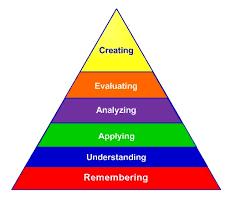
There are different enhanced features in the revised approach of Bloom’s taxonomy [8]. Many times, it’s not possibletodrawa rigidline betweenthevariouslearning levelsattainedbythelearnersforaparticularCO.
Many authors write the engineering books containing numeroussolvedproblems.However,theconceptsarenot explainedatarealdepth.Suchbooksresembleready-made notes.Theylackinimpartingthedesiredlevelofknowledge component to the readers. To add to this, the current generation the so called smart learners adopt “short- cut” way of learning a course by referring sub-standard study material.
Thoughnotall;but,someoftheengineeringteachershavea tendency to refer such books and solve the problems in a highlymechanicalway.Perhaps,aherculeantaskofcovering the voluminous content in shorter semester duration compels them to adopt a quick and examination-oriented teaching style. Many teachers and learners make use of moderntoolsandmethods.However,thesedon’tnecessarily ensure that the concepts are taught and learnt at the requireddepth.
Asamatteroffact,thenatureofquestionsusuallyaskedin termtestsandendsemesterexaminationsrequiresstraight forward approach, without posing much challenge to the lateral and fundamental thinking capacity of the learners. Hence, Bloom’s learning levels and corresponding course outcomeareattainedforthedocumentationpurpose.Onthe contrary,whenthequestionspertainingtothesameBloom’s learning levels, with a little logical twist are posed, how many learners will even try to attempt those is a milliondollar question. More importantly, what about the attainmentofBloom’slearninglevel,whichisdecidedonly based on the “verb” used in the CO statement? The elite engineering learners, generally from the premier engineeringinstitutes,maybeabletoanswerthequestions whichdemandlogicalthinking,owingtotheirquickgrasping
ability,combinedwiththeirself-studycapability.However, thoseareveryfewinalargepoolofengineeringlearners.
5. DEMONSTRATION OF ANALYSIS OF STATICALLY DETERMINATE, PERFECT, STABLE PIN-JOINTED PLANE TRUSS: BLOOM’S LEARNING LEVEL 4
Mechanical Approach: Analysethetrussshowninfigure2 anddetermineaxialforcesinthemembers,usingmethodof joints.
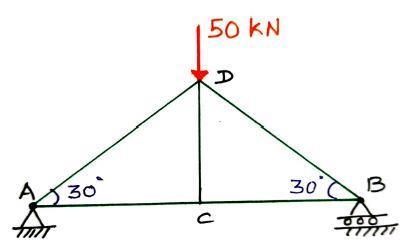
- 2: Pin-JointedPlaneTruss
Solution: AtB,rollercannotdevelopanyreactionparallelto its base; so horizontal reaction HB = 0. As no load acts in horizontaldirectiononthetruss,HA =0.
Duetothesymmetryofloadingandtrussgeometry,vertical reactionsatAandBare25kNeach,intheupwarddirection, toresistthedownwardloadof50kN.
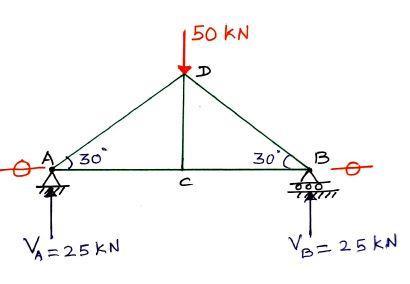
- 3: ReactionsoftheTruss
Thereare4joints,A,B,CandD,eachformingaconcurrent forcesystem.Hence,onlytwoequilibriumequations,Σfx =0 and Σfy = 0 can be applied at each joint. Obviously, a joint withunknownforcesnotmorethan2hastobeselectedto beginwith.Thereare2suchjoints,i.e.AandB.
JointAwith2unknownmemberforces,FADandFAC,hasbeen selected.
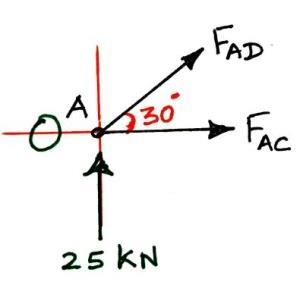
- 4:

International Research Journal of Engineering and Technology (IRJET) e-ISSN: 2395-0056
Volume: 12 Issue: 01 | Jan. 2025 www.irjet.net p-ISSN: 2395-0072
Boththememberforceshavebeenassumedastensileforces. Tensile forces are considered positive and compressive forcesareconsiderednegativeinthecalculations.
Σfy =0(upward+ve)gives,25+FAD Sin300 =0
So,FAD =-50kN
-vesignindicatesthattheforceiscompressive.
Σfx =0(rightward+ve)gives,FAC +(-50Cos300)=0
So,FAC =43.30kN(Tensile)
Duetosymmetryofloadingaswellasgeometry,FAD =FBD andFAC =FBC
Now,jointCcanbeselected.
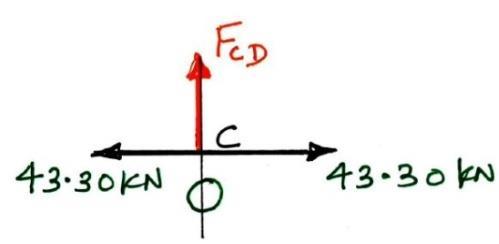
Fig. - 5: FBDofJointC
Σfy =0(upward+ve)gives,FCD =0
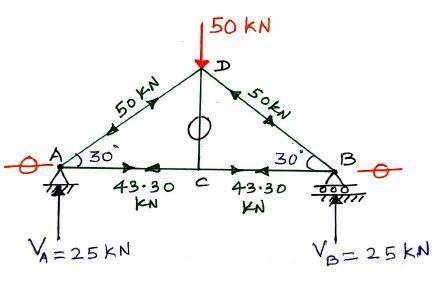
Fig.- 6: ForcesinAlltheMembers
Logical Approach: Analyse the truss shown in figure 2 without making use of support reaction values and determineaxialforcesinthemembers.Usemethodofjoints.

Fig. - 2 (Repeated): Pin-JointedPlaneTruss
Solution: As support reactions are not to be used in the calculations,jointsAandBcannotbeselected.Thoughthere
are3unknownsatjointC,therearenoinclinedmembersat thisjoint.Moreover,noloadisactingatC.
So,FCD=0forverticalequilibriumofjointC.Thisshowsthat DC is a dummy member, carrying no force. However, its removalwouldmakethetrussdeficientandunstable.
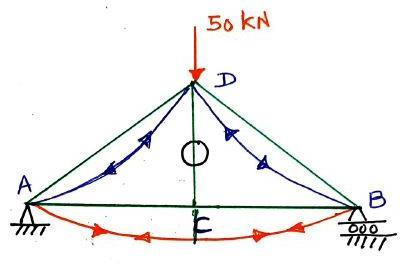
Fig. - 7: DeformedShapeoftheTruss
Referringfig.7,trussdeformsdueto50kNloadinsucha way that the members AD and BD are subjected to axial shortening;soFADandFBDarecompressiveforces.Members ACandBCaresubjectedtoaxialelongation;soFAC andFBC are tensile forces. Using this fundamental structural engineering“commonsenseandlogic”,thenatureofaxial forces have been already decided before calculating their magnitudes. This logic obviously applies to trusses with greater number of members and loadings as well. More importantly,itfacilitatesincross-checkingthecorrectnessof thenatureofaxialforcesobtainedthroughthecalculations.
ConsideringjointD,memberDCcarriesnoforce;members ADandBDeachcarryhalftheeffectofload50kN,owingto thesymmetry.
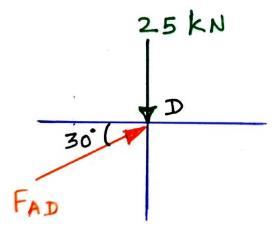
Fig. - 8: PartialFBDofJointD
It’salreadyknownfromthedeformedshapethatFADwillbe compressive;so,thereisno needtoassumeitasa tensile forceinitially
AD will carry half the effect of 50 kN; therefore, 25 kN is shownatD.
Σfy =0(upward+ve)gives,FAD Sin300 -25=0
So,FAD =50kN(Compressive)=FBD

International Research Journal of Engineering and Technology (IRJET) e-ISSN: 2395-0056
Volume: 12 Issue: 01 | Jan. 2025 www.irjet.net p-ISSN: 2395-0072
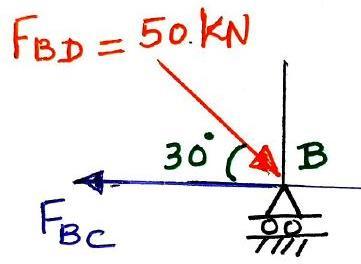
Fig. - 9: JointBDetails
Referringfig.9,itisobviousthatFBC mustbe(50Cos300)= 43.30kN(Tensile)forthehorizontalequilibriumofjointB. AtjointC,FAC=43.30kN(Tensile)forhorizontalequilibrium ofthejoint.
Detailedstepshavebeenexplainedjustforthepurposeof demonstration.However,inlogicalapproach,onecanobtain the answers quickly without writing too many formal mathematical steps and without drawing too many diagrams.
The mechanical approach followed the usual set rules of method of joints and it was more of stereotype way of solving a problem, without requiring a critical thinking approach. However, when the same problem was solved complyingwiththeconstraintofnotusingsupportreactions, it necessitated fundamental knowledge of structural engineeringandlogicalthinking.Thismaynotbethecup-oftea of majority of the students. Many students would struggletoobtainthesolutionwiththeimposedconstraint.
Enormousstudymaterialisavailableintheprintformand digitalformlikeYouTubevideos;MOOCSnotesandvideos, Googlesearchenginecontent,etc.Thoughnotall;butmost ofthismaterialreflectshighlymechanicalwayofsolvinga problem throughfollowing stepsina chronological order. Stickingtothemechanicallysetrules,everytime,isinsharp contrast to the very purpose of engineering philosophy itself!!!.Herecomestheroleofanintellectualcreaturei.e. “human being”. Hence, it becomes imperative for an engineering teacher to impart critical thinking to the learnersbyexercisinganextraeffortinordertomaketheir fundamentalsstrongandsound.Thismaynotbepossiblein everycasebyadopting“ArtificialIntelligence(ActuallyNonHumanIntelligence)”.Anengineeringteachershalladopta teaching style, wherein an optimal combination of mechanical and logical approach can be practiced for the OBEphilosophytoberealizedinapragmaticsense.
ApplestartedfallingnotbecauseNewtoninventedgravity law!!!. Itwasfallingsincetimeimmemorial;Newtoncould give reasoning to it with his logical explanation. On the similar line, engineering principles do not follow mathematics;rathermathematicalapproachhastobeused
to express the engineering concept. If learners get accustomed simply to use mathematical equations and formulae to solve an engineering problem, without really understanding the underlying engineering principles, will theybeabletoacquiretherequiredpracticalknowledge? If an engineering concept, pertaining to a certain CO and learninglevel,istaughttothelearnersasapartofcovering regularcoursesyllabusandifquestionsbasedonitappearin relativelytoughcompetitiveexaminationsorunexpectedly difficult university examination paper, requiring logical thinkingandsoundengineeringfundamentals,thelearners should be able to solve it completely or at least develop a logictopartiallytackletheproblem.Thiswouldtrulyreflect theCOandlearninglevelattainments.
ThoughattainmentisvitalandessentialinOBEframework, thesuccessofengineeringeducationcannotbeonlyconfined to and measured by the attainments of CO and learning levelsintheformaldocumentshavingmoreofaquantitative approach;ithasalsotobeassessedqualitativelyintermsof graduatesacquiringthestrongengineeringconceptswhich isanessentialfactorinobtaininganengineeringdegree.
DecidingtheattainmentsofBloom’slearninglevelandCO based only on the usage of an appropriate “verb” symbolicallyinaCOstatementistooshallow,immatureand superficial way of dealing with a particular course. On a Professional note, it shows a lack of real seriousness expected in engineering teaching-learning process. The engineeringlearnersmustbetaught“what”todo,“how”to doandveryimportantly“why”todo.Ifthelastcomponentis missing,thenitissimply“OutputBasedEducation”,smartly projectedas“OutcomeBasedEducation”.Insuchacase,the CO statement has to be changed to: “The students will be abletoanalyzethetrussonlywithreferencetothequestions pertaining to what to do and how to do way of thinking” Thisstatementmayseemtobefunnytosomeofthereaders, butalittleconsiderationwouldunderlineaseriousmessage itcarries.
The teachers and learners must do Strength, Weakness, Opportunity and Challenge (SWOC) analysis for selfintrospection and work honestly towards overcoming Weakness and Challenge, with the help of Strength and Opportunity.Consideringthe“2-minutenoodles”attitudeof the current generation learners, the onus is on the engineeringteacherstoconvincethemtheimportanceofindepthstudythroughimpartingtheknowledgeconceptually andlogicallysothat,atleastsomeofthelearnerscanattain theexpectedlearninglevelandthecourseoutcomeinareal sense!!!.......Tillthen,acrossmanyinstitutesinIndia,thesame oldstorycontinuesandsodoesthecolossaldocumentation (by cutting thousands of trees so that one of the vital Sustainable Development Goals is not attained in a real sense!!!!!)………………..??????...........

International Research Journal of Engineering and Technology (IRJET) e-ISSN: 2395-0056
Volume: 12 Issue: 01 | Jan. 2025 www.irjet.net p-ISSN: 2395-0072
[1] Sumathi R., Savithramma R. M., and Ashwini B. P. A Systematic Framework for Designing and Implementing Outcome-Based Curriculum in Engineering Education: A ComprehensiveApproach.JournalofEngineeringEducation Transformations(JEET).Jan.2024 SpecialIssue;Vol.No.37.
[2] Hadgraft R. G., and Kolmos A. Emerging Learning Environments in Engineering Education. Australasian JournalofEngineeringEducation.2020;25(1),3–16.
[3]PatilDada.AsEngineeringTeachers,DoWeResembleA T20 Cricket Batsman or A Test Cricket Batsman?: Let Us Introspect International Research Journal of Engineering andTechnology(IRJET).October2024;Vol.11,Issue10.
[4] Mohanty R. C., and Panda B. N. How to Become a CompetentTeacher? NewDelhiIndia:DiscoveryPublishing House;2003.
[5] Idachaba, F. Outcome Based Engineering Curriculum Design:aSystemforCurriculumStreamliningandGraduate Quality Improvement in Engineering. INTED 2018 Proceedings,1(March),5888–5893.
[6]Gope,D.,andGope,A. Studentsandacademiciansviews on the engineering curriculum and industrial skills requirement for a successful job career. Open Education Studies.2022;4(1),173–186.
[7] Sumathi R., Savithramma R. M., and Ashwini B. P. CurriculumComplianceImprovementModelforAddressing Program Outcomes in Engineering Education. Journal of Engineering Education Transformations (JEET). 2023; 37(1).
[8]AndersonL.W.,andKrathwohlD.R.(eds.).Taxonomyfor learning, teaching and assessing: A revision of Bloom's Taxonomyof educational objectives.New York:Longman; 2001.
AUTHOR’S BIOGRAPHY

Dr.DadaSubhashPatilisworking as an Associate Professor in Civil EngineeringDepartmentinAIKTC, Panvel,NaviMumbai,India.Hehas 23yearsofexperience.Hisareasof interestareStructuralEngineering, Advanced Concrete Technology, GeotechnicalEngineering,Effective Teaching-Learning Process in Engineering, Outcome Based Education,etc.